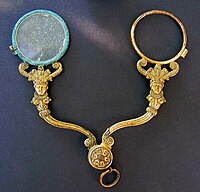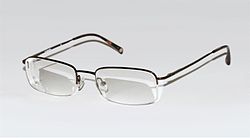"Spectacles" redirects here. For other uses, see
Spectacle
(disambiguation)
– also called
eyeglasses (formal),
spectacles, or
specs (informal) – are frames bearing
lenses 
worn in front of the
eyes,
normally for
vision correction 
or
eye protection.
Safety glasses are a kind of
eye protection
against flying debris or against visible and near visible
light
or
radiation.  Sunglasses
Sunglasses 
allow better vision in bright daylight, and may protect against damage from high levels of
ultraviolet light
. Other types of glasses may be used for viewing visual information (such as
stereoscopy
) or simply just for aesthetic or fashion values.
Historical types of glasses include the
pince-nez
,
monocle, lorgnette
lorgnette
, and scissor or
scissors-glasses.
Modern glasses are typically supported by pads on the bridge of the
nose
and by
temple arms (sides) placed over the
ears. CR-39
CR-39
lenses are the most common plastic lenses due to their low weight, high scratch resistance, low
dispersion,
and low transparency to ultraviolet and infrared radiation. Polycarbonate and Trivex lenses are the lightest and most shatter-resistant, making them the best for impact protection.
[1]
An unpopular aspect of glasses is their inconvenience. Even through the creation of light frames such as those made of
titanium
, very flexible frames, and new lens materials and
optical coatings
, glasses can still cause problems during rigorous sports. Visibility can be significantly reduced by becoming greasy, trapping vapour when eating hot food, swimming, walking in rain or rapid temperature changes (such as walking into a warm building from cold temperatures outside). Scraping, fracturing, or breakage of the lenses require time-consuming and costly professional repair, though modern plastic lenses are almost indestructible and very scratch-resistant.
 (disambiguation)
(disambiguation)

0 comments:
Post a Comment